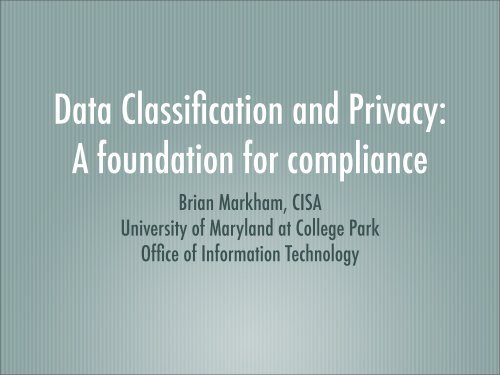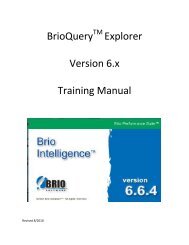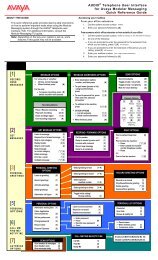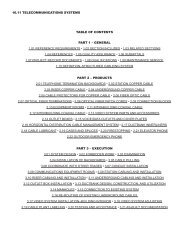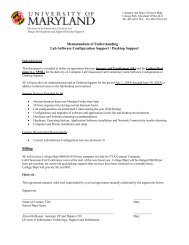Data Classification and Privacy - Office of Information Technology ...
Data Classification and Privacy - Office of Information Technology ...
Data Classification and Privacy - Office of Information Technology ...
Create successful ePaper yourself
Turn your PDF publications into a flip-book with our unique Google optimized e-Paper software.
<strong>Data</strong> <strong>Classification</strong> <strong>and</strong> <strong>Privacy</strong>:<br />
A foundation for compliance<br />
Brian Markham, CISA<br />
University <strong>of</strong> Maryl<strong>and</strong> at College Park<br />
<strong>Office</strong> <strong>of</strong> <strong>Information</strong> <strong>Technology</strong>
Goals for today:<br />
Give you a solid underst<strong>and</strong>ing <strong>of</strong> both <strong>Data</strong> <strong>Classification</strong> <strong>and</strong><br />
<strong>Data</strong> <strong>Privacy</strong> with respect to compliance;<br />
Link data classification <strong>and</strong> privacy to ongoing compliance<br />
issues;<br />
Discuss various best practices, methodologies, <strong>and</strong> approaches<br />
that you can take with you;<br />
Do my best to answer any questions you may have on audit<br />
related issues regarding these topics.
So...who am I?<br />
IT Compliance Specialist @ the <strong>Office</strong> <strong>of</strong> <strong>Information</strong> <strong>Technology</strong><br />
at UMCP<br />
Responsible for audit <strong>and</strong> compliance initiatives within OIT<br />
Formerly employed by KPMG LLP <strong>and</strong> Grant Thornton LLP as an<br />
IS Auditor<br />
Have worked with many federal, state, <strong>and</strong> local governments as<br />
well as public companies, hospitals, <strong>and</strong> not-for-pr<strong>of</strong>its.
Why do we want to be in compliance?<br />
No one likes audit findings;<br />
Reduces organizational risk;<br />
Processes based on best practice <strong>and</strong> widely adopted st<strong>and</strong>ards<br />
are more effective than ad-hoc processes;<br />
Systems <strong>and</strong> data are more secure as a result <strong>of</strong> good internal<br />
control practices.
What is <strong>Data</strong> <strong>Privacy</strong>?<br />
<strong>Data</strong> <strong>Privacy</strong> - the relationship between technology <strong>and</strong> the legal<br />
right to, or public expectation <strong>of</strong> privacy in the collection <strong>and</strong><br />
sharing <strong>of</strong> data.<br />
The U.S. has trailed the E.U. <strong>and</strong> other countries in data privacy<br />
regulations <strong>and</strong> legislation;<br />
Passed Legislation: HIPAA, Gramm-Leach-Bliley, COPPA;<br />
Proposed Legislation: <strong>Data</strong> Accountability <strong>and</strong> Trust Act, Personal<br />
<strong>Data</strong> <strong>Privacy</strong> <strong>and</strong> Security Act <strong>of</strong> 2007 (S. 495).
Why <strong>Data</strong> <strong>Privacy</strong>?<br />
To protect people’s personal information under the law;<br />
We want to comply with the law;<br />
We want to be able to classify our data to adequate protect data<br />
that should be private.
What is <strong>Data</strong> <strong>Classification</strong>?<br />
<strong>Data</strong> classification is the act <strong>of</strong> placing data into categories that<br />
will dictate the level <strong>of</strong> internal controls to protect that data<br />
against theft, compromise, <strong>and</strong> inappropriate use.<br />
<strong>Information</strong> security is best managed when data is classified <strong>and</strong><br />
the risks associated with each category is uniform <strong>and</strong><br />
understood.<br />
<strong>Data</strong> classification is an essential part <strong>of</strong> audit <strong>and</strong> compliance<br />
activities at any organization; public or private sector.
Why Classify <strong>Data</strong>?<br />
Simply put: EVERY IT general control audit requires some sort <strong>of</strong><br />
data classification st<strong>and</strong>ard or approach.<br />
FISCAM: “Classify information resources according to their<br />
criticality <strong>and</strong> sensitivity”<br />
State <strong>of</strong> MD: “Documenting <strong>and</strong> ensuring that a process is<br />
implemented for the classification <strong>of</strong> information in accordance<br />
with the <strong>Information</strong> Sensitivity <strong>and</strong> <strong>Classification</strong> St<strong>and</strong>ard”<br />
USM Guidelines: “Identify critical systems – high value, high<br />
risk, critical service, critical data”
St<strong>and</strong>ards <strong>and</strong> Best Practices<br />
NIST has developed FIPS-199 as a guideline for federal agencies<br />
The IT Governance Institute has included data classification in<br />
COBIT 4.0<br />
“Establish a classification scheme that applies throughout the enterprise, based on the<br />
criticality <strong>and</strong> sensitivity (e.g., public, confidential, top secret) <strong>of</strong> enterprise data. This<br />
scheme includes details about data ownership, definition <strong>of</strong> appropriate security levels<br />
<strong>and</strong> protection controls, <strong>and</strong> a brief description <strong>of</strong> data retention <strong>and</strong> destruction<br />
requirements, criticality <strong>and</strong> sensitivity. It is used as the basis for applying controls<br />
such as access controls, archiving or encryption.” - ITGI
St<strong>and</strong>ards <strong>and</strong> Best Practices (cont.)<br />
The IT Governance Institute has also listed data classification as<br />
an important component for Sarbanes Oxley section 404<br />
compliance.<br />
“Managing systems security includes both physical <strong>and</strong> logical controls that prevent<br />
unauthorized access. These controls typically support authorization, authentication,<br />
nonrepudiation, data classification <strong>and</strong> security monitoring. Deficiencies in this area<br />
could significantly impact financial reporting.” - ITGI
St<strong>and</strong>ards <strong>and</strong> Best Practices (cont.)<br />
As a response to FISMA, NIST developed FIPS-199 in 2003.<br />
FIPS-199 is the Federal Government’s answer to data<br />
classification.<br />
It is a framework that can be easily understood, adopted, <strong>and</strong><br />
implemented.<br />
It is based upon two components: security objectives <strong>and</strong><br />
potential impacts.
FIPS-199<br />
Three security objectives: Confidentiality, Integrity, Availability<br />
(CIA);<br />
Three levels <strong>of</strong> potential impact: Low, Moderate, High;<br />
Was developed as a response to the E-Government Act <strong>of</strong> 2002<br />
(Title III, also known as FISMA);<br />
Applies to all Federal Agencies.
FIPS-199 (cont.)<br />
According to FISMA:<br />
CONFIDENTIALITY<br />
“Preserving authorized restrictions on information access <strong>and</strong> disclosure, including means for<br />
protecting personal privacy <strong>and</strong> proprietary information…” [44 U.S.C., Sec. 3542]<br />
A loss <strong>of</strong> confidentiality is the unauthorized disclosure <strong>of</strong> information.<br />
INTEGRITY<br />
“Guarding against improper information modification or destruction, <strong>and</strong> includes ensuring<br />
information non-repudiation <strong>and</strong> authenticity…” [44 U.S.C., Sec. 3542]<br />
A loss <strong>of</strong> integrity is the unauthorized modification or destruction <strong>of</strong> information.<br />
AVAILABILITY<br />
“Ensuring timely <strong>and</strong> reliable access to <strong>and</strong> use <strong>of</strong> information…” [44 U.S.C., SEC. 3542]<br />
A loss <strong>of</strong> availability is the disruption <strong>of</strong> access to or use <strong>of</strong> information or an information system.
FIPS-199 (cont.)<br />
In plain English:<br />
Confidentiality - <strong>Data</strong> <strong>Privacy</strong> Laws <strong>and</strong> Regulations<br />
Integrity - How critical is it that data not be altered<br />
Availability - Result <strong>of</strong> a Business Impact Analysis (BIA)
FIPS-199 (cont.)<br />
According to FIPS-199, low, moderate, <strong>and</strong> high refer to the<br />
potential impact on organizations should their be a breach in<br />
security (CIA). Specifically:<br />
The potential impact is LOW if: The loss <strong>of</strong> confidentiality, integrity, or availability could be expected<br />
to have a limited adverse effect on organizational operations, organizational assets, or individuals.<br />
The potential impact is MODERATE if: The loss <strong>of</strong> confidentiality, integrity, or availability could be<br />
expected to have a serious adverse effect on organizational operations, organizational assets, or<br />
individuals.<br />
The potential impact is HIGH if: The loss <strong>of</strong> confidentiality, integrity, or availability could be expected<br />
to have a severe or catastrophic adverse effect on organizational operations, organizational assets,<br />
or individuals.
FIPS-199 (cont.)<br />
So why implement FIPS-199?<br />
It has been widely adopted by the Federal Government;<br />
It ties back to best practice guidance developed by NIST;<br />
FISCAM is the manual that is used by OLA to audit us; FISCAM<br />
is also the manual used to audit the Federal Government;<br />
Being in line with FIPS-199 can only help us in the Federal<br />
grant application process.
FIPS-199: The Nine Box<br />
\ Low Moderate High<br />
Confidentiality<br />
Integrity<br />
Availability<br />
SC (<strong>Information</strong> Type) = {(Confidentiality, impact), (Integrity, impact), (Availability, impact)}
FIPS-199: The Nine Box<br />
\ Low Moderate High<br />
Confidentiality<br />
Integrity<br />
Availability<br />
X<br />
X<br />
SC Public <strong>Information</strong> = {(Confidentiality, NA), (Integrity, Moderate), (Availability, Moderate)}
But wait...there’s more!<br />
Some institutions have GREAT home grown, best practice based<br />
data classification policies:<br />
George Washington University<br />
Stanford University<br />
University <strong>of</strong> Texas - Austin
Stanford’s <strong>Data</strong> <strong>Classification</strong> Guidelines<br />
Source: http://www.stanford.edu/group/security/securecomputing/dataclass_chart.html
Other Resources<br />
Educause has a toolkit available online that provides step-bystep<br />
process guidance <strong>and</strong> templates;<br />
These materials provide a blueprint for h<strong>and</strong>ling data in a<br />
manner that is appropriate with laws, regulations, <strong>and</strong><br />
compliance st<strong>and</strong>ards.<br />
https://wiki.internet2.edu/confluence/display/secguide/Confidential<br />
+<strong>Data</strong>+H<strong>and</strong>ling+Blueprint#Confidential<strong>Data</strong>H<strong>and</strong>lingBlueprint-Step2
How to Implement<br />
Self Assessment: what are we doing now?<br />
Choose a methodology/st<strong>and</strong>ard for data classification;<br />
Classify data sets based on the approved methodology;<br />
Classify systems based on data types that they process;<br />
Re-Assess classifications for both data <strong>and</strong> systems annually.
Also check out...<br />
http://csrc.nist.gov/publications/PubsSPs.html<br />
http://csrc.nist.gov/publications/PubsFIPS.html<br />
http://www.isaca.com<br />
http://www.itgi.com
Audit Artifacts<br />
A data classification policy;<br />
Risk assessments by system;<br />
Completed data classifications (by system);<br />
DR strategy to ensure high criticality data/systems is protected<br />
against loss or damage;<br />
Annual reviews <strong>of</strong> data classification policy <strong>and</strong> ratings.
Key Takeaways:<br />
<strong>Data</strong> <strong>Privacy</strong> for certain types <strong>of</strong> data is m<strong>and</strong>ated by law;<br />
More stringent data privacy legislation is coming;<br />
<strong>Data</strong> must be understood <strong>and</strong> classified in order to be<br />
adequately managed, controlled, <strong>and</strong> protected.<br />
Once critical data <strong>and</strong> systems have been identified controls<br />
must be implemented to achieve the privacy that is required.<br />
Annual assessments <strong>of</strong> classifications <strong>and</strong> controls are necessary.
Questions?<br />
Contact Me at:<br />
(301) 405.1057<br />
bmarkham@umd.edu<br />
http://www.eyeonbooks.com/gallery/lesko.jpg<br />
http://www.eyeonbooks.com/gallery/lesko.jpg


